Wondering what a twin needle is and why you would need to use one? Read my first post about sewing with a twin needle here.
In this post, I explain how to thread a double needle and show you some examples of twin needle use on stretch knit fabrics and on woven fabrics.
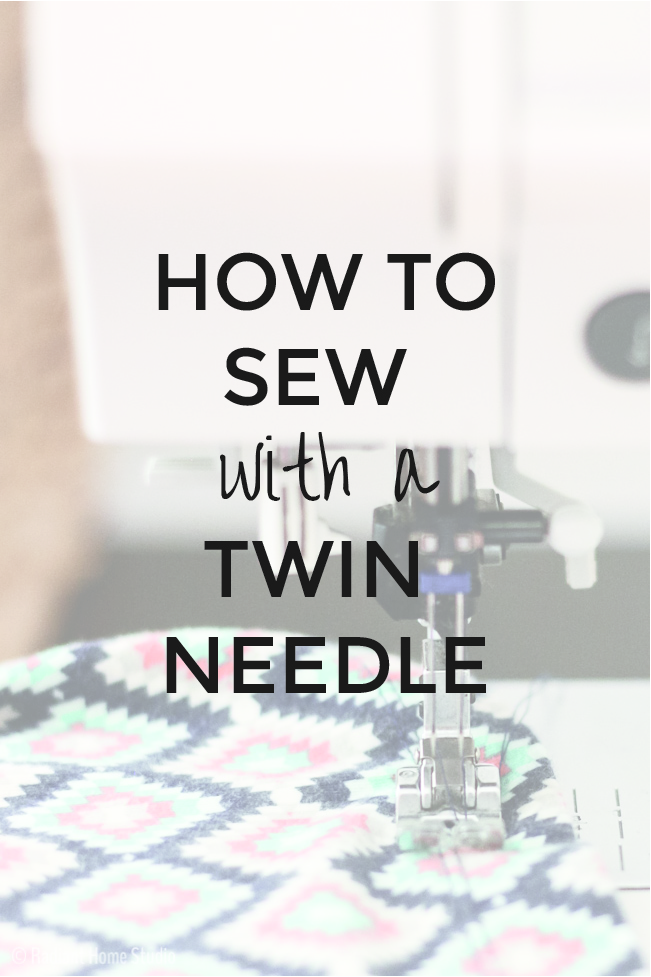
How Do I Use a Twin Needle?
You will need to consult your sewing machine manual for specific directions about twin needle use on your machine, but I will demonstrate on mine (a Pfaff) to give you the general idea.
Loosen the screw that holds your current needle and carefully remove it. Make a mental note about the direction the needle shaft fits in your machine. In all of the machines I have used, the flat part of the shaft faces the back of the machine (but I think there are a couple of exceptions, so double check!). Insert the new needle and tighten the screw.
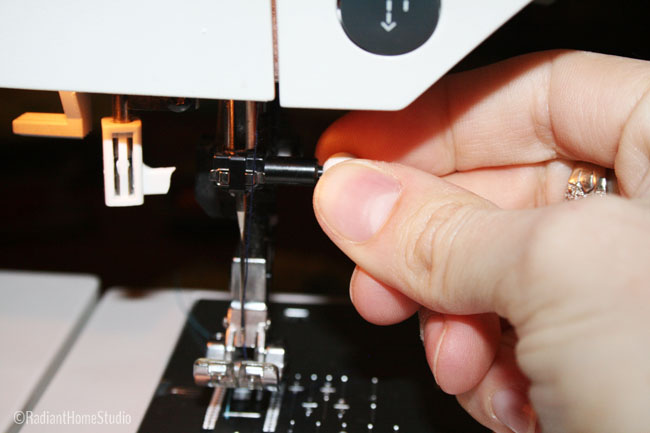
To thread the machine, you will need two spools of thread and one bobbin. (If you don’t have two spools of the same color, wind an extra bobbin and use that.) You will also need to locate an extra spool holder in the accessories for your machine. Most of the time, this is just a 3″ plastic rod that fits into a hole on the top of your machine. Sometimes the extra spool can be placed onto the bobbin winding pin instead. If neither of these options works, you can place your spool in a coffee mug next to your machine and wind it from there.
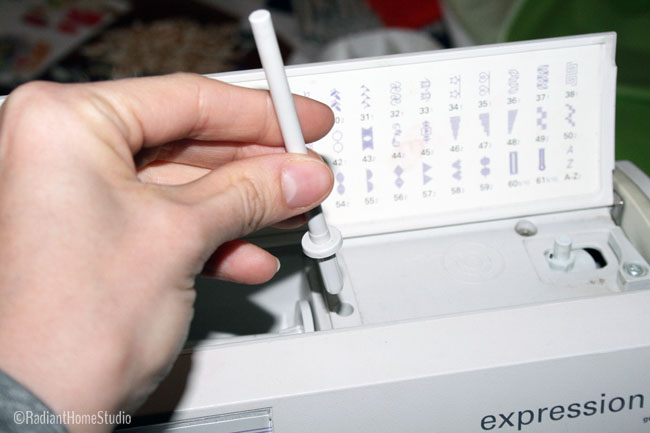
Arrange your spools of thread on the holders so that the thread spins off in opposite directions. This will help prevent tangling.
Thread the machine normally, making sure to separate the threads when you guide them through the tension disk.
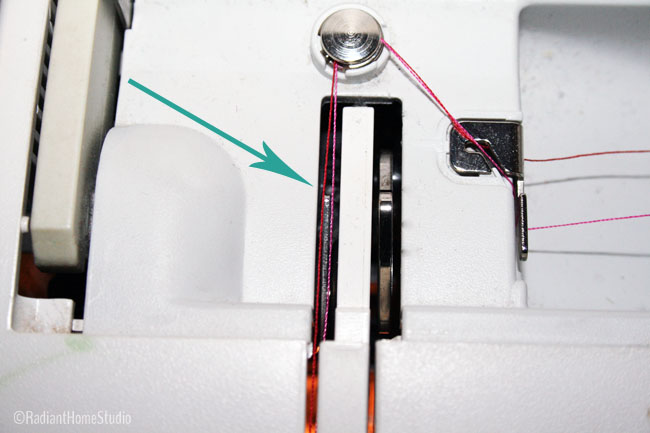
If you have separate guides near the needle shaft, put one thread through each. If not, just slide them in together and put one thread through each needle eye.
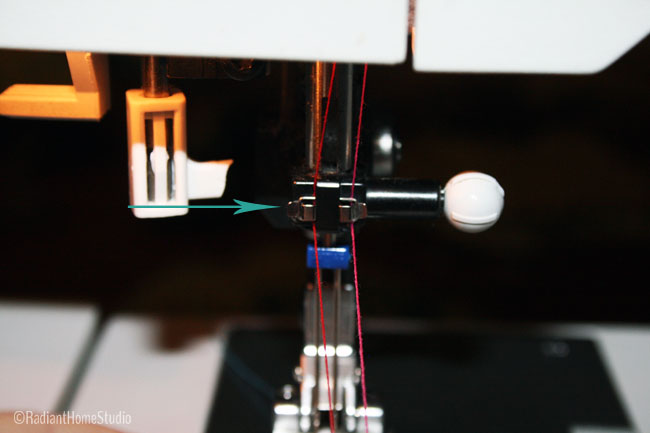
Rotate your hand wheel to guide your bobbin thread up as usual.
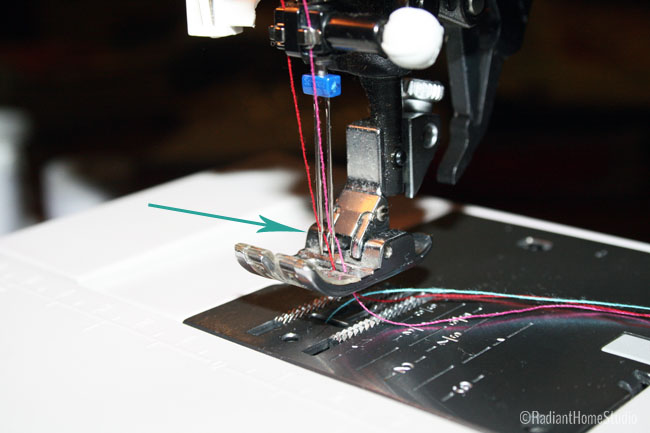
Troubleshooting Twin Needle Problems:
I highly recommend testing your threading and tension on a piece of scrap fabric. I typically don’t need to make any major adjustments. I lower the tension just a notch or two for a basic jersey knit fabric.
Below are some examples, so that you can see how changing the tension affects your stitching. Number 1 is the lowest tension setting, and number 4 is the highest. (My machine has settings 1-8, so these are 2 step increments.) You can see that numbers 1 and 2 look best on the front, 3 is starting to pucker, a number 4 is very puckered and pinched up.
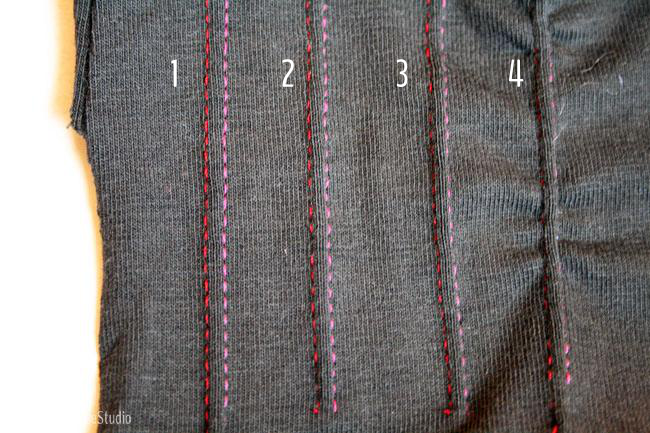
On the back, you can see that number 1 isn’t quite right. The top threads are pulling through. For this fabric, I would set my tension to the 2nd setting for the best results.
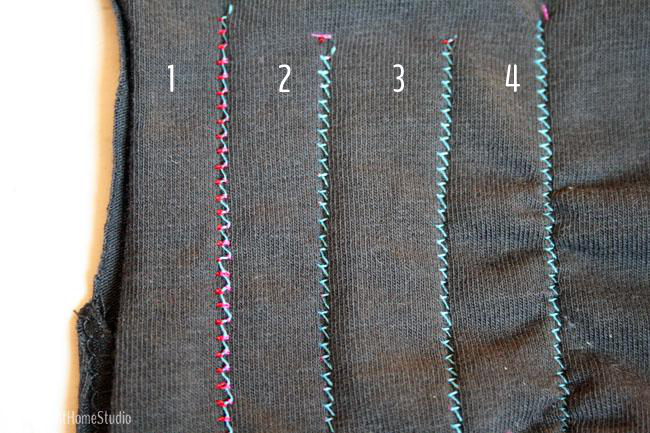
If your machine is skipping stitches or tangling your threads, remove and reinsert your bobbin and rethread your machine.
If your stitching lines are pinched together and your zigzag is barely visible from the back, lower your tension.
If your zigzag is loose or top threads can be seen from the back, raise your tension.
Examples of Twin Needle Use:
Joining or hemming stretch knits:
You can use a twin needle for regular seams in stretch fabrics. The second row of stitching adds extra strength, while the zigzag provides the stretch needed to keep the threads from breaking. You can also use the twin needle to make clean, even hems that mimic a coverstitch (that nice finish on store-bought t-shirts that can only be made with a very expensive serger).
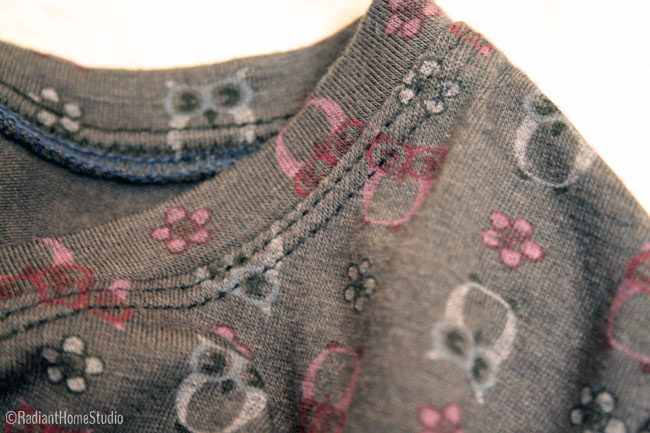

Creating pintucks:
To create pin tucks, choose a double needle with a narrow distance between the points. Raise your tension to a high setting and test to make sure you get the desired result. To make the tucks even tighter, you can gently pull the bobbin thread ends as you do when gathering fabric. Tie a small knot, in the end, to keep the tension tight.
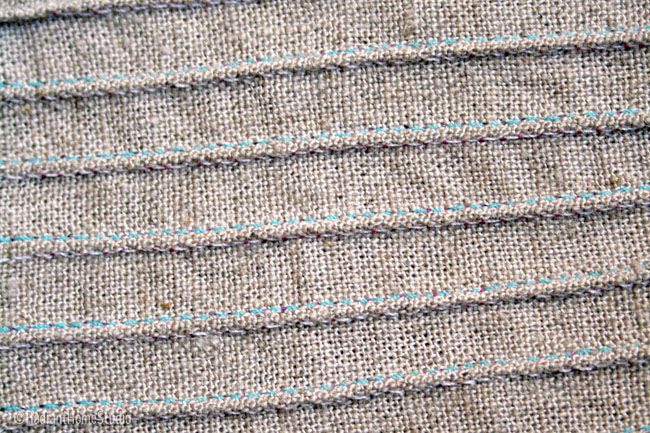
Decorative topstitching:
Generally, you want to use a straight stitch with your double needle. However, some of the narrower decorative machine stitches may produce beautiful and interesting patterns when you use a twin needle. You may want to try some of these with different thread colors as well.
Check your manual to find out which stitches you can use with a twin needle. Wide zigzag stitches may cause your needle to hit the presser foot and break. My machine has a digital display for each stitch which shows whether or not it can be used with a twin needle. Many of the decorative stitches can be used when I reduce the stitch width.
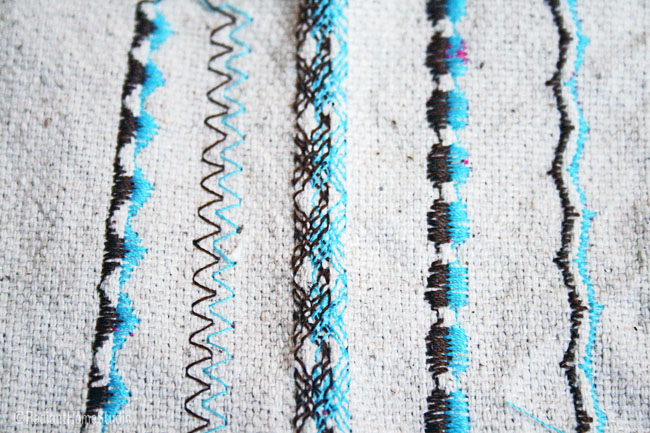
(See the pink bobbin thread? That means I need to lower my tension. It’s always a good idea to test your stitches on the fabric you are using for your project to identify these problems. It’s much faster than picking out the stitches later!)
Here are a few examples of twin needle use that may give you some more ideas:
Katy explains how to use twin needles for swimsuit fabric.
This post has more helpful tips for threading a double needle and lots of helpful tips in the comments.
And here’s a beautiful heirloom baby dress with twin needle pintucks.
Have you tried using twin needles? What is your favorite way to use them?



Question about tension adjustments — are we talking thread tension (in the bobbin case) or presser foot tension? I’ve never messed with thread tension and totally nervous about it!
Definitely don’t mess with the bobbin case! That should be left to the pros. I have never had reason to change that. Your thread tension can be adjusted with a dial or buttons at the top or side of your machine. Mine starts at 0 and goes to 8. 0 is no tension and 8 pulls the thread very tightly. I usually sew with it on 4, but adjust it for some tricky fabrics. On my machine there is also a marking on #3 for button holes. That is where I like to set it for sewing with the fancy stitches.
I have 2 bobbin cases – one has looser tension for decorative BOBBIN thread – I hardly ever use it, I might add. I keep it carefully separated from the other one LOL
That’s a nice feature! What type of machine is it? I don’t think I’ve ever heard of that before.
I have a Pfaff – 20 years old, still going strong! It should, for the price I paid LOL
I have a used Pfaff about that age. I wonder if I have that feature…
It’s just an extra removable bobbin case whose tension can be adjusted.
Great Tutorial and photos. I have not been able to sew for a while but I really enjoy looking at everyone else’s work. I am going to try this with a Bernina as soon as I can.
Great site!
Thank you! Glad you stopped by and commented!
Hi.. I have tried this on an old Singer machine I have and one of the top threads kept getting tight to the point of breaking one half of the twin needle.. any idea what to do then?.. am I threading up wrong (I can’t find the manual!).
thanks
It sounds like a threading problem to me. First, check to see that your threads are on opposite sides of the tension disk. Second, make sure the thread is coming off the spools in opposite directions so that they don’t get tangled.
You can try looking for your machine manual online. There are some sites that have PDF copies of old manuals.
If all else fails, take your machine to the local quilt shop and see if they can help you. For something like that, I don’t expect they would even charge you for it.
Hi…I just bought a twin needle for my old Singer sewing machine (model 9124). Twin needle and extra spool holder are shown in the manual as options to purchase, even though the manual does not tell you anything about how to use them. I threaded as directed on your website and several others, two threads via the regular route then through each needle, however; I end up with only a regular line of stitching on my practice fabric scrap (the inner needle does not seem to connect with the bobbin for some reason). Thank you in advance for any ideas on how to go about fixing this problem.
That’s very interesting. I wish I could see it in person. My first suggestion is just to take out the bobbin, make sure it’s in correctly, and clean any lint out of the bobbin area. I’d also rethread the top, just to be sure nothing is getting caught. Usually when I have issues with skipped stitches, rethreading nearly always solves the problem. The only thing I can think of it that there is some tension on that inner thread that is keeping it from being pulled down through the fabric. If you can’t figure it out at home, take it over to your local quilt shop. For something that simple, I’m pretty sure they can help you get it working at no charge.
Hi
I love the look of the twin needle stitching on knits and have done it a few times however, it always seems to break and then come unravelled. Is it just cos the garments are too tight? (they don’t seem to be). Do i need to have no strain on the hem through walking etc? It’s frustrating as I make these clothes, they look great and then the hem pops out the first time I wear them. Hope you can help. Thanks, alix.
Besides the tips in my post, you might:
-lower the tension on your machine
-make sure the threads are not getting tangled and placing more strain on the stitching
-try wooly nylon serger thread, as it has some stretch to it
Thank you was unsure of what to do with needle guide because mine has one bar and didn’t seem right to just leave it hanging loose.
Glad to help! Thanks for stopping by 🙂
It is one of my New Year Sewing resolutions to do more sewing with a twin needle. You have inspired to stop procrastinating and just do it.
Great! I hope your experimenting works out well 🙂
Great info! I’m just trying a twin stretch for the first time. Any idea why the bobbin thread is only catching one of the twin threads? It seems to just ignore the other, so the needle punches through the fabric but doesn’t do anything else. Does this mean my machine isn’t designed to use twins? Thanks again for the great post. 🙂
Thanks Sylvia! I don’t recall ever having that problem. If you have re-threaded it a few times, I’m not sure what else to recommend. As long as the thread is threaded through each needle, the bobbin should catch. I haven’t ever used a machine that didn’t accommodate a twin needle. Do you have a local quilt/sewing machine shop? Usually the workers are super helpful. If you are willing to take your machine over there, I’m sure they can help you get it working. In my experience, they rarely charge for small things like that…
Hi, Just a quick note about different sewing machines, and a question about needles.
The bit about separating the theads before they go through the tension disk doesn’t apply to lots of machines. My Elna for example, has a single slot, with all the actual tension gadgetry hidden inside, and the manual says to thread both threads together until they get to the needle bar, where they go through separate thread guides. Like you said, best to look at the manual for the machine!
Is there any noticeable difference between a ‘ballpoint’ and a ‘stretch’ twin needle? I’m getting a lot of skipped stitches with a ballpoint – would a stretch twin needle help?
Thanks for the extra insight about your machine! As far as the needles, I haven’t noticed a difference on my own machine, but I the stretch needle is designed to prevent skipping stitches. I’m not sure how, but that’s what I read 🙂 The stretch needle seems to have a slightly sharper point. I think it would be worth a try if you don’t have any problems with skipped stitches normally!
Thank you so much for your tips. I am sewing my first knit ever as well as the first time with a twin needle. I have a Pfaff Ambition 1.0 and was unsure of what to do with the two spools. Your tip about using two holders and having them spin off in opposite directions makes a lot of sense. My first run through, the thread jammed, but I had both spools on one holder. I am excited to try your suggestion.
Thank you to you, Sara, and others who generously share their knowledge.
Thank you Francine! Good luck with your twin needle sewing!
Hi there,
Thanks for your post. I have a really old Pfaff, it seemed to twin needle fine on non-stretch fabrics but now I can’t get it to work at all. The bobbin thread doesn’t seem to be catching the top threads, so I’m not getting any stitches at all. I notice when I start sewing the threads go all saggy above the needle thread guide catcher (the clip just before you thread through the eye of the needle).
Any suggestions would be great!
Hmm. Well, I haven’t had any problems like that. I would double check the manual if you can find it (sometimes they are online). If you haven’t missed any steps, I’d try taking it to a local Pfaff dealer. My local shops have always been good about looking at problems like that at no charge. If it’s just a mistake in the threading or settings, they should be able to get it working in a couple of minutes. But if there’s a bigger problem, like with the tension or timing, they’ll be able to tell that too.
Hi, I’ve been working with woven and lycra for a long time, with mixed results. I’ve only recently discovered how useful a twin needle is, but contrary to what your post says, I’m getting my stitching lines pinched together, even with the tension at zero, and the zigzag is loose on the back. It makes no sense.
I have a retro kenmore sewing machine, I think from the 70s. It’s super heavy (all metal parts) and I only have a standard zigzag foot. I’ve read elsewhere that a walking foot can really help when working with the stretch or fine material, do you have any idea where I could find additional feet for my older machine?
Sometimes knit bunches like that. Set your tension so the back is right. I’d also recommend stabilizing the seam with knit interfacing or knit hem tape. Then give it a good press when you finish sewing. Sometimes that’s all it needs. I do think a walking foot would be helpful. It’s useful for a lot of other projects too, so I think it’s worth having if you sew a lot anyway. I’d suggest searching ebay for one. You can always contact the seller to make sure it’s the right foot for your model.
Okay, that’s great advice. Thanks so much!